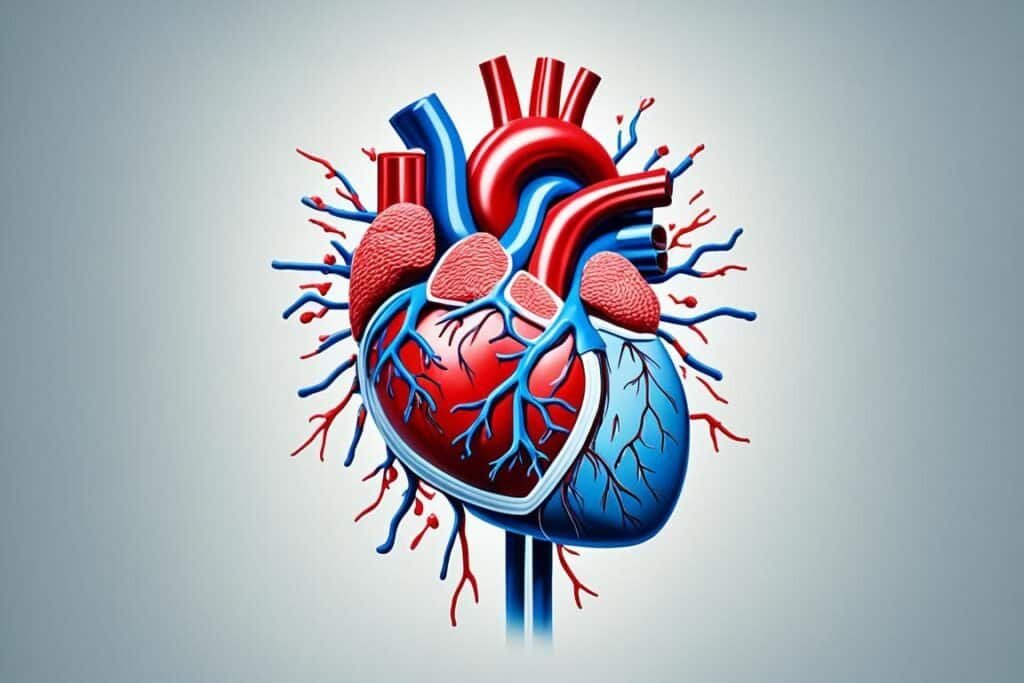If you or a loved one has experienced a heart attack, it’s important to understand the potential complications that may arise during the recovery process. While some individuals may have a “minor” heart attack with no associated complications, others may face more serious challenges. From arrhythmias to heart failure, these complications can range from mild to life-threatening.
It’s crucial to be aware of the potential risks and seek prompt medical attention to reduce the likelihood of complications and improve long-term heart health. By taking proactive measures and understanding the treatment options available, you can navigate the aftermath of a heart attack with confidence.
Key Takeaways:
- After a heart attack, individuals may experience various complications, ranging from mild to severe.
- Potential complications include arrhythmias, heart failure, cardiogenic shock, and heart rupture.
- Seeking prompt medical attention and proper management can help reduce the risk of complications.
- Treatment options for complications may include medication, surgery, and lifestyle changes.
- Managing underlying health conditions is essential in preventing complications and maintaining heart health.
Arrhythmias Following a Heart Attack
After experiencing a heart attack, it is important to be aware of potential complications that may arise. One common complication is the development of arrhythmias, which are abnormal heartbeats caused by damage to the heart muscles. These arrhythmias can lead to various symptoms and pose serious risks to your heart health.
Arrhythmias can manifest in different ways, with symptoms such as heart palpitations, chest pain, dizziness, tiredness, and breathlessness. These irregular heart rhythms disrupt the normal functioning of the heart and can significantly impact your daily life.
Among the various types of arrhythmias, two particularly serious forms to be aware of are complete heart block and ventricular arrhythmia. Complete heart block is a condition in which electrical signals are blocked, causing the heart’s upper and lower chambers to beat out of sync. Ventricular arrhythmia refers to abnormal heart rhythms originating from the ventricular chambers, the lower chambers of the heart. Both conditions can lead to sudden cardiac arrest, a life-threatening emergency.
Treatment options for arrhythmias following a heart attack depend on the specific type and severity of the condition. Your healthcare provider may prescribe medications, such as beta blockers, to regulate your heart’s rhythm and reduce symptoms. In some cases, implantable cardioverter defibrillators (ICDs) or pacemakers may be recommended to help manage and control arrhythmias effectively.
Monitoring your heart health after a heart attack is crucial. Regular follow-up visits with your doctor, routine electrocardiograms (ECGs), and other diagnostic tests can help detect and manage any arrhythmias that may arise. By staying proactive and seeking medical attention when needed, you can minimize the impact of arrhythmias on your overall heart health.
Dietary Tips for Heart Health
- Consume a balanced diet rich in fruits, vegetables, whole grains, lean proteins, and healthy fats.
- Avoid excessive salt and added sugars in your meals.
- Limit the intake of saturated and trans fats found in red meat, full-fat dairy products, and processed foods.
- Include omega-3 fatty acids in your diet, which can be found in fatty fish like salmon, mackerel, and sardines.
- Opt for low-fat or fat-free dairy products.
- Choose healthier cooking methods like baking, grilling, or steaming instead of frying.
- Stay hydrated by drinking an adequate amount of water throughout the day.
| Food Group | Serving Size | Examples |
|---|---|---|
| Fruits | 1 cup or 1 medium-sized fruit | Apples, bananas, oranges, berries |
| Vegetables | 1 cup raw or 1/2 cup cooked | Leafy greens, broccoli, carrots, peppers |
| Whole Grains | 1 serving | Brown rice, whole wheat bread, quinoa |
| Lean Proteins | 3-4 ounces (about the size of a deck of cards) | Chicken breast, fish, tofu, legumes |
| Healthy Fats | 1-2 tablespoons | Olive oil, avocado, nuts, seeds |
Heart Failure as a Complication of a Heart Attack
After experiencing a heart attack, it is possible to develop heart failure as a complication. Heart failure occurs when the heart is unable to effectively pump blood due to extensive damage to the heart muscle, especially in the left ventricle.
One of the main symptoms of heart failure is breathlessness, which can occur even during rest or minimal physical activity. Fatigue is another common symptom, where individuals may feel excessively tired and lacking energy for daily tasks. Swelling, specifically in the arms and legs, is also a sign of heart failure.
Treatment options for heart failure usually involve a combination of medications and lifestyle changes. Medications, such as angiotensin-converting enzyme (ACE) inhibitors or beta blockers, help manage symptoms and improve heart function. In some cases, surgery or medical devices like implantable cardioverter-defibrillators (ICDs) or ventricular assist devices (VADs) may be necessary to support heart function.
In addition to medical interventions, managing underlying health conditions like high blood pressure and diabetes is crucial in preventing heart failure and reducing its impact. Making healthy lifestyle choices, including regular exercise, a balanced diet, and maintaining a healthy weight, can also contribute to overall heart health.

Treatment Options for Heart Failure
When it comes to treating heart failure, there are various approaches that healthcare professionals may consider. Some of the commonly used treatments include:
- Medications: As mentioned earlier, medications such as ACE inhibitors, beta blockers, and diuretics can help manage symptoms and improve heart function.
- Angioplasty: This procedure involves opening narrowed or blocked blood vessels to ensure better blood flow to the heart.
- Coronary Artery Bypass Grafting (CABG): CABG is a surgical procedure that bypasses blocked coronary arteries using blood vessels from other parts of the body. This helps restore blood flow to the heart.
- Implantable Devices: Devices like ICDs and VADs may be implanted to regulate heart rhythm and assist with pumping blood.
- Heart Transplant: In severe cases of heart failure, a heart transplant may be the best option to restore heart function.
Every individual’s treatment plan may vary depending on the severity of heart failure and other factors. It’s essential to work closely with healthcare professionals to determine the most suitable treatment options.
Cardiogenic Shock: A Serious Complication of a Heart Attack
Cardiogenic shock is a severe and potentially life-threatening complication that can occur after a heart attack. It occurs when the heart muscle has been extensively damaged, leading to the inability to pump enough blood to maintain normal body functions. This can put tremendous stress on the body and vital organs.
Symptoms of cardiogenic shock can manifest in various ways. Patients may experience mental confusion, cold hands and feet, decreased urine output, rapid heartbeat, pale skin, and difficulty breathing. These symptoms indicate that the body is not receiving enough oxygen and nutrients, which can have serious consequences if left untreated.
Immediate medical intervention is necessary to stabilize the initial symptoms of cardiogenic shock. Doctors may administer medications known as vasopressors, which help increase blood pressure and improve circulation. These medications work by constricting blood vessels and narrowing the arteries, thereby improving blood flow to vital organs.
In some cases, surgery may be required to improve heart functioning and treat cardiogenic shock. Two common surgical procedures used in the treatment of cardiogenic shock are percutaneous coronary intervention (PCI) and coronary artery bypass graft (CABG). PCI involves the use of a balloon-tipped catheter to open blocked coronary blood vessels and restore blood flow. CABG, on the other hand, involves creating new pathways for blood to bypass blocked or narrowed coronary arteries, thus restoring normal blood flow to the heart.
Managing and treating cardiogenic shock requires a multidisciplinary approach involving cardiologists, cardiothoracic surgeons, and critical care specialists. The primary goal is to stabilize the patient and improve heart function to prevent further complications.
Awareness of the signs and symptoms of cardiogenic shock is crucial in seeking immediate medical attention. If you or someone you know experiences symptoms such as mental confusion, cold hands and feet, decreased urine output, rapid heartbeat, pale skin, or difficulty breathing after a heart attack, it is vital to seek emergency medical care without delay.

| Symptoms of Cardiogenic Shock | Treatment Options |
|---|---|
| Mental confusion | Vasopressors |
| Cold hands and feet | Percutaneous coronary intervention (PCI) |
| Decreased urine output | Coronary artery bypass graft (CABG) |
| Rapid heartbeat | |
| Pale skin | |
| Difficulty breathing |
Heart Rupture: A Rare but Serious Complication of a Heart Attack
While most complications following a heart attack can be managed with appropriate medical intervention, heart rupture is an extremely serious and relatively uncommon complication that requires immediate attention. Heart rupture occurs when the heart’s muscles, walls, or valves split apart due to significant damage. This can lead to life-threatening conditions such as heart failure or cardiogenic shock.
Heart rupture typically happens soon after a heart attack, when the heart muscles are weakened and vulnerable. The severity of the rupture can vary, ranging from a small tear to a complete rupture. The consequences of heart rupture can be severe, impacting the heart’s ability to effectively pump blood and supply oxygen to the body.
Requiring immediate medical attention, heart rupture often necessitates open heart surgery to repair the damage and stabilize the condition. During the surgery, the torn areas of the heart are repaired or replaced, and any associated complications are addressed. It is a highly specialized procedure that requires the expertise of a cardiac surgeon.
The recovery process following open heart surgery for heart rupture can be challenging, as it involves a period of hospitalization and close monitoring. Depending on the severity of the rupture and individual circumstances, rehabilitation and lifestyle modifications may also be necessary to support the healing process and prevent future complications.
Risk Factors for Heart Rupture
| Risk Factors | Description |
|---|---|
| Previous heart attack | A history of a prior heart attack increases the likelihood of heart rupture. |
| Extensive heart muscle damage | The severity of heart muscle damage is directly correlated to the risk of heart rupture. |
| Delay in seeking medical care | Not seeking immediate medical attention after a heart attack can increase the risk of heart rupture. |
| Older age | Advanced age is a known risk factor for heart rupture. |
It is crucial for individuals who have experienced a heart attack to be aware of the signs and symptoms of heart rupture, such as sudden and severe chest pain, shortness of breath, rapid heartbeat, and a drop in blood pressure. If these symptoms occur, immediate medical attention should be sought to minimize the risks associated with heart rupture.
Conclusion
Complications following a heart attack, such as arrhythmias, heart failure, cardiogenic shock, and heart rupture, can have serious consequences and pose a threat to your life. However, by seeking immediate medical attention and managing your condition properly, you can reduce the risk of these complications and improve your long-term heart health.
Awareness and understanding of potential complications are crucial. Take note of any abnormal heart rhythms, symptoms of heart failure like breathlessness and fatigue, signs of cardiogenic shock such as mental confusion and rapid heartbeat, or indicators of heart rupture such as severe chest pain. If you experience any of these symptoms, do not hesitate to contact your healthcare provider.
Prevention is key in safeguarding your heart health. Adopting a healthy lifestyle, including a balanced diet, regular exercise, and stress management, can significantly reduce the risk of complications. It is also essential to manage underlying health conditions such as high blood pressure and diabetes, as they can contribute to the development of complications following a heart attack.
Being prepared for emergencies is crucial. Familiarize yourself with cardiac emergency procedures and the location of the nearest medical facility. By taking proactive measures, seeking immediate medical care, and maintaining a healthy lifestyle, you can protect your heart health, minimize the long-term effects of a heart attack, and enjoy a healthier life.

